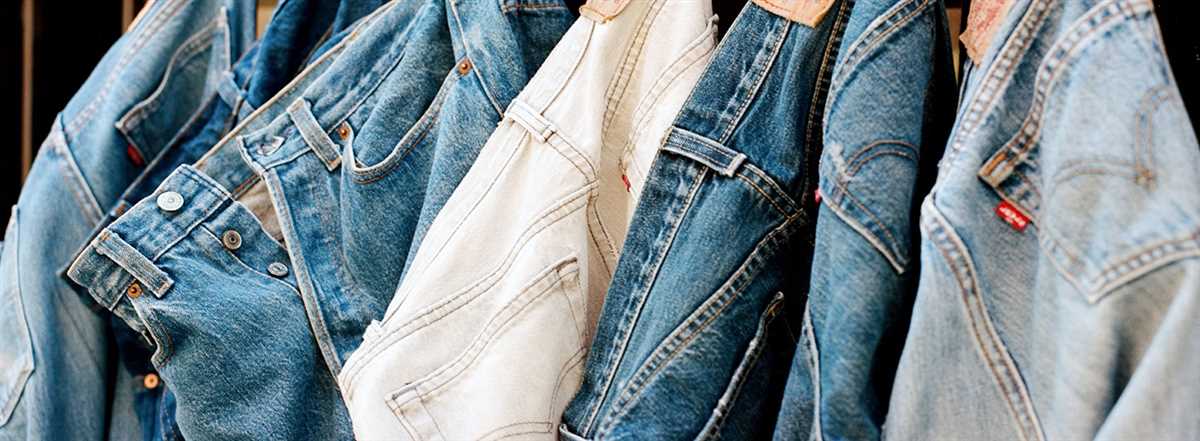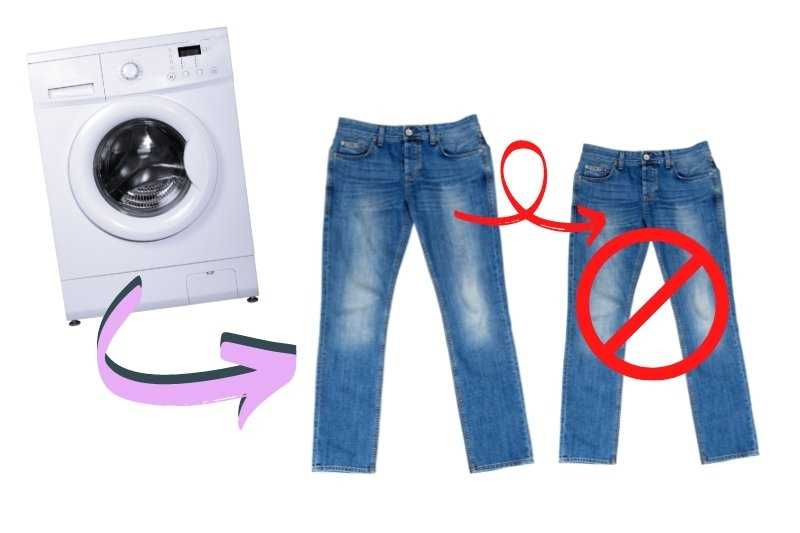




Jeans are a staple in many people’s wardrobes, known for their durability and classic style. However, one question that often arises is whether jeans shrink over time. This article will explore the effects of wear and washing on the size and fit of jeans.
Wearing and washing jeans can cause them to shrink due to the properties of the fabric. Jeans are typically made from denim, a cotton-based fabric that has a tendency to shrink when exposed to heat or moisture. Both wearing and washing jeans involve subjecting them to these elements, which can lead to changes in their size and fit.
When jeans are worn, they stretch and conform to the shape of the body, resulting in a comfortable fit. However, with prolonged wear, the fabric can lose some of its elasticity and resilience, causing the jeans to become looser and potentially longer in the leg. This can be particularly noticeable in areas such as the waistband and knees, where the fabric is most prone to stretching.
Washing jeans can also contribute to shrinkage. The combination of water, heat, and agitation can cause the cotton fibers in the denim to contract, resulting in a tighter fit. This is why it is often recommended to wash jeans in cold water and hang them to dry, as hot water and high heat from the dryer can accelerate shrinkage.
In conclusion, jeans can shrink over time due to the effects of wear and washing. While this shrinkage may be more noticeable in some areas than others, it is a natural result of the fabric properties and should be expected. To minimize shrinkage, it is best to wash jeans in cold water and air dry them whenever possible. Additionally, choosing jeans with a blend of fabrics that offer stretch and recovery can help maintain their shape over time.
The Nature of Jeans
Jeans are a type of pants that are typically made from denim fabric. They are known for their durability and versatility, making them a popular choice for casual and everyday wear. Jeans were originally designed as workwear in the mid-19th century but have since become a fashion staple.
Denim, the fabric used to make jeans, is a sturdy cotton twill textile. It is woven in a way that creates a diagonal ribbing pattern, known as the twill weave. This weave improves the durability and strength of the fabric, making it suitable for heavy-duty use.
Features of Jeans

Jeans often feature various design elements that contribute to their unique style:
- Rivets: Jeans are typically reinforced with metal rivets at the pockets and stress points. These rivets help prevent the fabric from tearing and enhance the overall durability of the garment.
- Stitching: Jeans are sewn with heavy-duty stitching to withstand regular wear and washing. The stitching is often done with contrasting thread colors, adding an aesthetic element to the garment.
- Pockets: Jeans usually have multiple pockets, including front pockets, back pockets, and sometimes additional smaller pockets. These pockets provide practical storage space for small items like keys, coins, or a mobile phone.
- Belt Loops: Most jeans have belt loops around the waistband, allowing wearers to accessorize their jeans with belts for both style and functionality.
Types of Jeans
Over the years, different styles and cuts of jeans have emerged, catering to various fashion trends and personal preferences. Some popular types of jeans include:
- Straight-leg: These jeans have a straight cut from the hips to the ankles, offering a classic and timeless look.
- Skinny: Skinny jeans are fitted and taper down from the hips to the ankles, creating a sleek and form-fitting silhouette.
- Bootcut: Bootcut jeans have a slightly flared leg opening, allowing them to accommodate boots or other footwear with ease.
- Boyfriend: Boyfriend jeans have a relaxed and baggy fit, resembling jeans that are borrowed from a boyfriend.
- Flare: Flare jeans have a bell-bottom shape with a wide leg opening, reminiscent of the fashion trends from the 1970s.
Caring for Jeans
To maintain the integrity and longevity of jeans, proper care is essential. Here are some tips for caring for jeans:
- Wash jeans inside out to help preserve the color and reduce fading.
- Avoid frequent washing, as this can cause jeans to lose their shape and elasticity.
- If necessary, spot clean stains instead of washing the entire pair of jeans.
- Air-dry jeans instead of tumble drying to prevent shrinkage or excessive wear.
- Consider storing jeans folded or hanging to avoid creases or wrinkles.
By following these care tips, jeans can maintain their fit and appearance over time.
Understanding Shrinkage
Shrinkage is a common concern when it comes to jeans, as many people have experienced their favorite pair shrinking after a few washes or a long period of wear. Understanding why jeans shrink can help you take better care of them and prevent unnecessary shrinkage.
Factors Contributing to Shrinkage
Several factors contribute to the shrinkage of jeans over time:
- Fabric: The type of fabric used in jeans plays a significant role in how much they will shrink. Natural fibers such as cotton tend to shrink more than synthetic fibers.
- Care Instructions: Following the care instructions provided by the manufacturer is crucial in maintaining the size and shape of jeans. Improper washing and drying techniques can lead to excessive shrinkage.
- Heat: High heat, whether from hot water or a hot dryer, can cause jeans to shrink. Heat makes the fibers contract, resulting in a smaller size.
- Agitation: The agitation during washing and drying can also contribute to shrinkage. The constant rubbing and movement of the fabric can cause it to tighten up and shrink.
Preventing and Minimizing Shrinkage

To prevent or minimize shrinkage in your jeans, follow these tips:
- Read the Care Label: Check the care label on your jeans for specific instructions on how to wash and dry them. Follow these instructions carefully to avoid shrinkage.
- Wash in Cold Water: Using cold water instead of hot water can help prevent shrinkage. Cold water is less likely to cause the fibers to contract.
- Air Dry or Use Low Heat: Instead of using a hot dryer, air dry your jeans or use a low heat setting. High heat can cause significant shrinkage, so it’s best to avoid it.
- Consider Professional Alterations: If you want to customize the fit of your jeans without risking shrinkage, consider taking them to a professional tailor who can make alterations without compromising the fabric.
Conclusion
Jeans can shrink over time due to factors such as fabric type, care instructions, heat, and agitation. By understanding these contributing factors and taking proper care of your jeans, you can minimize shrinkage and prolong their lifespan.
Effects of Wear and Tear

Jeans are a staple in many people’s wardrobes, and with regular wear and tear, they can start to show signs of aging. Here are some of the effects that wear and tear can have on jeans:
- Fading: Over time, jeans can start to fade, especially in areas where there is a lot of friction, such as the knees and thighs. This is caused by the dye gradually wearing off from the fabric.
- Distressing: Distressing refers to intentional wear and tear that is added to jeans to give them a worn-in and vintage look. This can include features like holes, fraying, and worn-out patches.
- Stretching: With regular wear, jeans can stretch out, especially in areas where the fabric is pulled or stretched. This can result in a looser fit and may require the jeans to be washed or dried to shrink back to the original size.
- Thinning: In areas where the jeans experience a lot of friction and rubbing, such as the inner thighs or seat, the fabric can start to thin out. This can lead to holes and tears if not addressed.
- Seam Wear: The seams of jeans can also experience wear and tear, especially in areas where there is a lot of movement, such as the crotch or waistband. This can result in visible fraying or even seams coming apart.
- Color Bleeding: With repeated washing, jeans can sometimes bleed color onto other fabrics. This can be especially noticeable with darker denim that has not been properly set or treated to prevent color bleeding.
It’s important to note that not all jeans will exhibit these effects at the same rate or to the same degree. The extent of wear and tear on jeans will depend on factors such as the quality of the denim, the frequency of wear, and how the jeans are cared for. Proper maintenance, such as gentle washing and repairs when needed, can help prolong the life of jeans and minimize the effects of wear and tear.
Impact of Washing
Washing jeans is a common practice in order to keep them clean and fresh. However, this routine task can have a significant impact on the overall fit and appearance of the jeans over time. Here are some key points to consider:
1. Shrinkage

When jeans are washed, they tend to shrink. This is mainly due to the heat and agitation in the washing machine, along with the moisture from the water. As a result, the jeans may become tighter and shorter after washing. It is important to pay attention to the washing instructions provided by the manufacturer to minimize the shrinkage.
2. Fading
Repeated washing can cause the color of jeans to fade over time. The dye used in denim is not always colorfast, which means it can easily fade with each wash. This is especially true for dark-colored jeans. To preserve the original color, it is recommended to wash jeans inside out and use cold water. Using a gentle detergent specifically designed for denim can also help minimize fading.
3. Distressing

Jeans that have been distressed or have undergone special treatments such as sanding or whiskering may lose their desired look after washing. The process of washing can further age and soften the fabric, potentially reducing the intentional distressed effects that were added during manufacturing. It is important to consider the desired level of distressing before deciding on the washing frequency.
4. Elasticity
Stretch denim jeans often contain a certain percentage of elastane or spandex, which provides elasticity and helps the jeans maintain their shape. However, frequent washing can affect the elasticity of the fabric, making it less stretchy over time. It is recommended to wash stretch jeans less frequently and avoid using the dryer, as the heat can further damage the elastane fibers.
In conclusion, washing jeans can have a significant impact on their fit, color, distressing, and elasticity. Taking proper care, following washing instructions, and considering the desired level of shrinkage, fading, distressing, and elasticity can help maintain the quality and appearance of jeans over time.
FAQ
Will my jeans shrink if I wear them regularly without washing?
Yes, it is possible for jeans to shrink slightly if you wear them regularly without washing. The friction and heat from daily wear can cause the denim fabric to shrink, although the effect may be minimal.
What is the best way to prevent jeans from shrinking?
To prevent jeans from shrinking, it is recommended to wash them in cold water and air dry them instead of using a dryer. Additionally, avoid high heat settings when ironing your jeans. Proper care and gentle washing can help minimize shrinkage.
Do all types of jeans shrink the same way?
No, different types of jeans may shrink differently depending on the fabric blend and construction. For example, jeans made of 100% cotton are more prone to shrinking compared to jeans with stretch or blended fabrics. It is important to check the care label and follow the manufacturer’s instructions for each pair of jeans.
Is it possible to stretch out shrunken jeans?
Yes, it is possible to stretch out shrunken jeans. One method is to soak the jeans in lukewarm water for about 30 minutes, then gently stretch and shape them while they are still damp. However, keep in mind that the stretching process may not restore the jeans to their original size completely, and it is best to prevent shrinkage in the first place by following proper care instructions.











